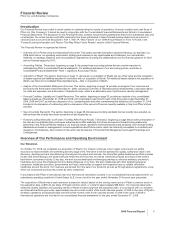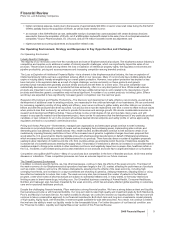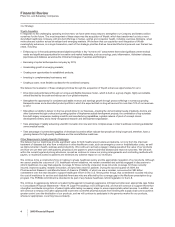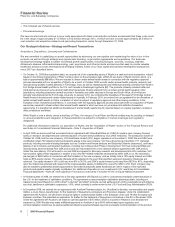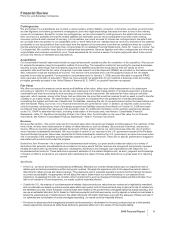Pfizer 2009 Annual Report Download - page 12
Download and view the complete annual report
Please find page 12 of the 2009 Pfizer annual report below. You can navigate through the pages in the report by either clicking on the pages listed below, or by using the keyword search tool below to find specific information within the annual report.
Financial Review
Pfizer Inc. and Subsidiary Companies
•Provisions for pharmaceutical returns are based on a calculation in each market that incorporates the following, as appropriate: local
returns policies and practices; returns as a percentage of sales; an understanding of the reasons for past returns; estimated shelf life by
product; and an estimate of the amount of time between shipment and return or lag time; and any other factors that could impact the
estimate of future returns, such as loss of exclusivity, product recalls or a changing competitive environment. In most markets, returned
products are destroyed, and customers are refunded the sales price in the form of a credit.
•We record sales incentives as a reduction of revenues at the time the related revenues are recorded or when the incentive is offered,
whichever is later. We estimate the cost of our sales incentives based on our historical experience with similar incentives programs.
Historically, our adjustments to actual have not been material; on a quarterly basis, they generally have been less than 1.0% of
Biopharmaceutical net sales and can result in a net increase to income or a net decrease to income. The sensitivity of our estimates
can vary by program, type of customer and geographic location. However, estimates associated with U.S. Medicaid and contract
rebates are most at-risk for material adjustment because of the extensive time delay between the recording of the accrual and its
ultimate settlement, an interval that can range up to one year. Because of this time lag, in any given quarter, our adjustments to
actual can incorporate revisions of several prior quarters.
Collaborative Arrangements––Payments to and from our collaboration partners are presented in the statements of income based on
the nature of the arrangement (including its contractual terms), the nature of the payments and applicable accounting guidance.
Under co-promotion agreements, we record the amounts received from our partners as alliance revenues, a component of
Revenues, when our co-promotion partners are the principal in the transaction and we receive a share of their net sales or profits.
Alliance revenues are recorded when our co-promotion partners ship the product and title passes to their customers and the related
expenses for selling and marketing these products are included in Selling, informational and administrative expenses. In
collaborative arrangements where we manufacture a product for our partner, we record revenues when our partner sells the product
and title passes to its customer. All royalty payments to collaboration partners are recorded as part of Cost of sales.
Long-Lived Assets
We review all of our long-lived assets, including goodwill and other intangible assets, for impairment indicators throughout the year
and we perform detailed impairment testing for goodwill and indefinite-lived assets annually and for all other long-lived assets
whenever impairment indicators are present. When necessary, we record charges for impairments of long-lived assets for the
amount by which the present value of future cash flows, or some other fair value measure, is less than the carrying value of these
assets. Examples of those events or circumstances that may be indicative of impairment include:
•A significant adverse change in legal factors or in the business climate that could affect the value of the asset. For example, a
successful challenge of our patent rights likely would result in generic competition earlier than expected.
•A significant adverse change in the extent or manner in which an asset is used. For example, restrictions imposed by the FDA or other
regulatory authorities could affect our ability to manufacture or sell a product.
•A projection or forecast that demonstrates losses associated with an asset. This could include, for example, a change in a government
reimbursement program that results in an inability to sustain projected product revenues and profitability. This also could include the
introduction of a competitor’s product that results in a significant loss of market share or the lack of acceptance of a product by patients,
physicians and payers.
Our impairment review process is described in the Notes to Consolidated Financial Statements—Note 1L. Significant Accounting
Policies: Amortization of Intangible Assets, Depreciation and Certain Long-Lived Assets.
Based on our analysis, none of our goodwill is impaired as of December 31, 2009, and we do not believe the risk of impairment is
significant at this time. See the “Forward-Looking Information and Factors That May Affect Future Results” section of this Financial
Review for additional information on future events and factors that may impact future results and potentially have an impact on any
future goodwill impairment tests.
We provide a valuation allowance when we believe that our deferred tax assets are not recoverable based on an assessment of
estimated future taxable income that incorporates ongoing, prudent, feasible tax-planning strategies.
The value of intangible assets is determined primarily using the “income approach,” which starts with a forecast of all the expected
future net cash flows, some of which are more certain than others. Some of the more significant estimates and assumptions inherent
in the intangible asset impairment estimation process include: the amount and timing of projected future cash flows; the discount
rate selected to measure the risks inherent in the future cash flows; and the assessment of the asset’s life cycle and the competitive
trends impacting the asset, including consideration of any technical, legal, regulatory or economic barriers to entry, as well as
expected changes in standards of practice for indications addressed by the asset.
The implied fair value of goodwill is determined by first estimating the fair value of the associated business. To estimate the fair
value of the Biopharmaceutical business, we generally use the “market approach,” where we compare the segment to similar
businesses or “guideline” companies whose securities are actively traded in public markets or which recently have been sold in a
private transaction. Within the Diversified business, we generally use the “income approach,” where we use a discounted cash flow
model in which cash flows anticipated over several periods, plus a terminal value at the end of that time horizon, are discounted to
their present value using an appropriate rate of return. Some of the more significant estimates and assumptions inherent in the
goodwill impairment estimation process using the “market approach” include: the selection of appropriate guideline companies; the
determination of market value multiples for the guideline companies and the subsequent selection of an appropriate market value
multiple for the business based on a comparison of the business to the guideline companies; and the determination of applicable
premiums and discounts based on any differences in ownership percentages, ownership rights, business ownership forms or
marketability between the segment and the guideline companies; and/or knowledge of the terms and conditions of comparable
10 2009 Financial Report



